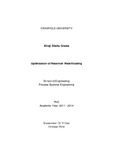JavaScript is disabled for your browser. Some features of this site may not work without it.
| dc.contributor.advisor | Cao, Yi | |
| dc.contributor.author | Grema, Alhaji Shehu | |
| dc.date.accessioned | 2015-06-18T09:51:00Z | |
| dc.date.available | 2015-06-18T09:51:00Z | |
| dc.date.issued | 2014-10 | |
| dc.identifier.uri | http://dspace.lib.cranfield.ac.uk/handle/1826/9263 | |
| dc.description.abstract | Waterflooding is a common type of oil recovery techniques where water is pumped into the reservoir for increased productivity. Reservoir states change with time, as such, different injection and production settings will be required to lead the process to optimal operation which is actually a dynamic optimization problem. This could be solved through optimal control techniques which traditionally can only provide an open-loop solution. However, this solution is not appropriate for reservoir production due to numerous uncertain properties involved. Models that are updated through the current industrial practice of ‘history matching’ may fail to predict reality correctly and therefore, solutions based on history-matched models may be suboptimal or non-optimal at all. Due to its ability in counteracting the effects uncertainties, direct feedback control has been proposed recently for optimal waterflooding operations. In this work, two feedback approaches were developed for waterflooding process optimization. The first approach is based on the principle of receding horizon control (RHC) while the second is a new dynamic optimization method developed from the technique of self-optimizing control (SOC). For the SOC methodology, appropriate controlled variables (CVs) as combinations of measurement histories and manipulated variables are first derived through regression based on simulation data obtained from a nominal model. Then the optimal feedback control law was represented as a linear function of measurement histories from the CVs obtained. Based on simulation studies, the RHC approach was found to be very sensitive to uncertainties when the nominal model differed significantly from the conceived real reservoir. The SOC methodology on the other hand, was shown to achieve an operational profit with only 2% worse than the true optimal control, but 30% better than the open-loop optimal control under the same uncertainties. The simplicity of the developed SOC approach coupled with its robustness to handle uncertainties proved its potentials to real industrial applications. | en_UK |
| dc.language.iso | en | en_UK |
| dc.publisher | Cranfield University | en_UK |
| dc.rights | © Cranfield University 2014. All rights reserved. No part of this publication may be reproduced without the written permission of the copyright owner. | en_UK |
| dc.subject | Optimal control | en_UK |
| dc.subject | Receding horizon control | en_UK |
| dc.subject | Self-optimizing control | en_UK |
| dc.subject | geological uncertainty | en_UK |
| dc.subject | controlled variable | en_UK |
| dc.subject | Open-loop solution | en_UK |
| dc.subject | feedback control | en_UK |
| dc.subject | reservoir waterflooding | en_UK |
| dc.title | Optimization of Reservoir Waterflooding | en_UK |
| dc.type | Thesis or dissertation | en_UK |
| dc.type.qualificationlevel | Doctoral | en_UK |
| dc.type.qualificationname | PhD | en_UK |
